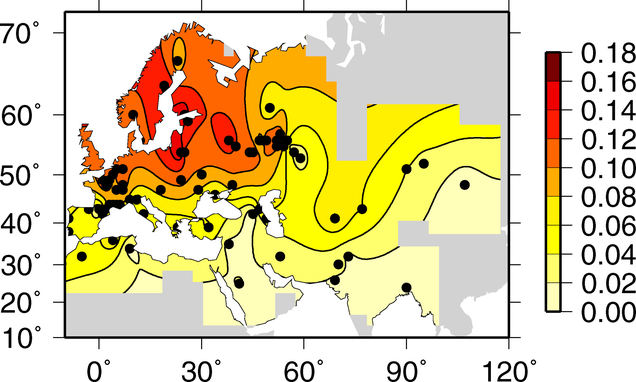Ancient Jews were probably like Assyrians and Armenians - that is, close to 0% of North_European.
Ancient Italians and Greeks - part of whom converted to Judaism - had much less of North_European than do modern ones.
That's because Italians and Greeks were admixed by Germanic and Slavic tribes in the Middle Ages.
Thus it was only during the Early Middle Ages, when percent of "North_European" among Greeks and Italians increased.
So modern 15% of North_European in Jews doesn't come from Ancient Italians and Greeks, at least not mostly from them.
As Semitic Duwa has pointed out, the only way to actually settle these issues is through ancient Dna. However, the data we have from modern populations doesn't support your conclusions.
In terms of the Germanic invasions, one way of tracing them is through yDna U-106 and I1, which are commonly viewed as modern "Germanic" markers. The numbers in Italy are very low as can be seen in Maciamo's compilation of modern European yDna. Even in northern Italy, which includes the Veneto, where we have the most archaeological evidence for them, the total is 7% for I1 and it's even lower for U-106 based on Maciamo's maps. R1a is 4.5%.
http://www.eupedia.com/europe/european_y-dna_haplogroups.shtml
http://cdn.eupedia.com/images/content/Haplogroup-R1b-S21.gif
You can also check Boattini et al.
http://journals.plos.org/plosone/article?id=10.1371/journal.pone.0065441
http://www.nature.com/ejhg/journal/vaop/ncurrent/full/ejhg2015138a.html
Anyone who is interested can go to the supplement here and click on Table S2 for the lineages by city.
http://journals.plos.org/plosone/article?id=10.1371/journal.pone.0065441#s6
There are discussions here at eupedia which can be found through the search engine.
Then there is the IBD analysis by Ralph and Coop:
http://journals.plos.org/plosbiology/article?id=10.1371/journal.pbio.1001555
"There is relatively little common ancestry shared between the Italian peninsula and other locations, and what there is seems to derive mostly from longer ago than 2,500 ya.. An exception is that Italy and the neighboring Balkan populations share small but significant numbers of common ancestors in the last 1,500 years."
"One of the striking patterns we see is the relatively high level of sharing of IBD between pairs of individuals across eastern Europe, as high or higher than that observed within other, much smaller populations. This is consistent with these individuals having a comparatively large proportion of ancestry drawn from a relatively small population that expanded over a large geographic area."
"This evidence is consistent with the idea that these populations derive a substantial proportion of their ancestry from various groups that expanded during the “migration period” from the fourth through ninth centuries."
Italy is one of "the regions of continental Europe thought to have been least affected by the Slavic and Hunnic migrations. These regions were, however, moved into by Germanic tribes (e.g., the Goths, Ostrogoths, and Vandals), which suggests that perhaps the Germanic migrations/invasions of these regions entailed a smaller degree of population replacement than the Slavic and/or Hunnic, or perhaps that the Germanic groups were less genealogically cohesive. This is consistent with the argument that the Slavs moved into relatively depopulated areas, while Gothic “migrations” may have been takeovers by small groups of extant populations."
There are various graphics illustrating these points.
Ancient dna may prove this information is misleading, but for now this is what we have.
These things have been posted here at Eupedia and elsewhere. It's not new information.
In terms of Slavic input, an IBD analysis has shown that there was some sharing but it is extremely minimal. That is not the source of the "Northern European" in Ashkenazi Jews.








